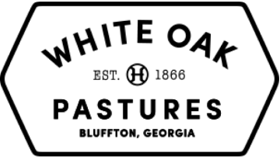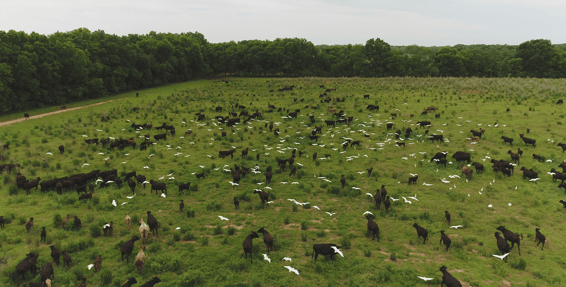
Grassfed beef is everywhere, from the grocery store to the restaurant menu. But what does “grassfed” actually mean?
Grassfed beef became popular so quickly that many folks were told to think it is “better”, without actually knowing any details. However, when you are able to see what the industrial, conventional production model looks like, it becomes clear that grassfed beef is better for animals, the environment, and rural communities.
Unfortunately, the industrialized, centralized food system has obscured what commodity food production actually looks like. Here, we pull back the curtain to reveal the real difference between pasture-raised, grassfed cattle and feedlot, grain-finished cattle.
What do these terms even mean?
Let’s start by clarifying some of the confusing vocabulary:
Conventional and Grain-Finished: All cattle in the United States start out on pasture, eating grass–technically, you could call all of this beef grassfed. However, after the calves are weaned (at less than a year old), conventionally-raised cattle are shipped to centralized feedlots known as concentrated animal feeding operations (CAFOs). Here, they are fed grain for several months to fatten up quickly before slaughter. This is why you will typically see these conventional cattle referred to as grain-finished.
Grassfed and Pasture-Raised: At White Oak Pastures, we refer to our cattle as grassfed and pasture-raised. Our cattle eat grass, as they were intended to, and we do not feed them any grain. We make the “pasture-raised” distinction because unfortunately, a producer may use a confined feedlot model, and if they technically feed the cattle grasses and hay on that feedlot, they can still market their beef as grassfed. However, our grassfed beef comes from animals who were raised on pasture, free to express their instinctive behaviors. We are committed to the welfare of our animals, who were born to roam and graze.
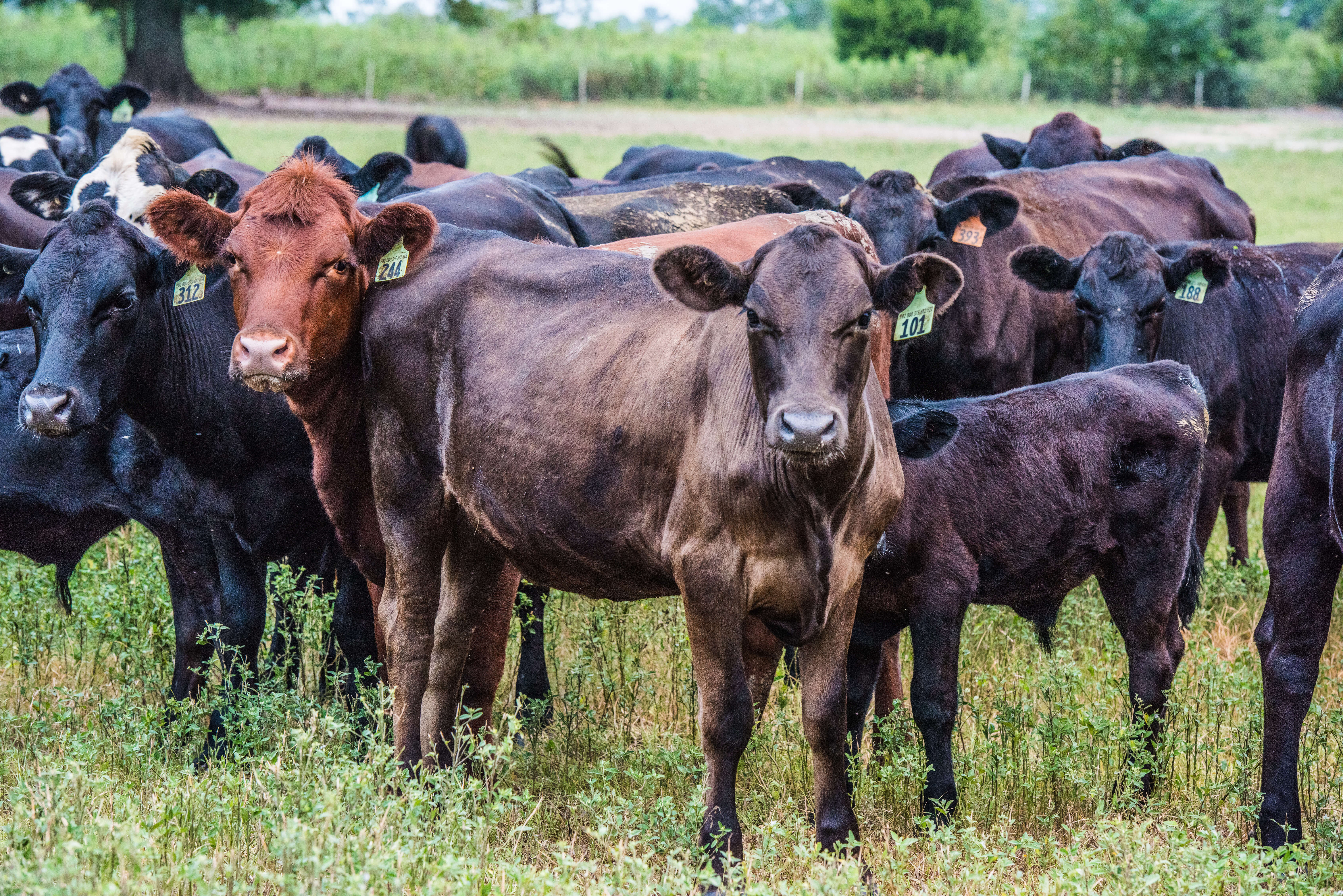
Here are the main ways in which our pasture-raised, grassfed model differs from conventional industrial agriculture:
Cattle Environment
Typical commodity, corn-finished cattle are confined to feedlot operations where movement is limited. These animals have feed and water brought to them, which means they gain weight faster.
Grassfed cattle raised on strictly forage (grass) diets are very active. As pasture-raised animals move to forage and access water, they burn calories and fat. These animals take longer to gain weight and are slaughtered at an older age. This activity and diet means that grassfed beef tends to be leaner than commodity beef items.
Cattle Diet
Conventional animals are “finished” by being fattened eating grains like corn, which is an unnatural diet high in carbohydrates. These animals may gain 5-6 pounds per day on the concentrated high-energy grain feed. Grains are digested faster than the cellulose cattle would get in a normal grazing diet, so these animals can eat more food and gain weight faster. The grain diet is tough on a ruminant’s digestive system, and they become unnaturally obese creatures with issues like ulcers, metabolic disorders, and suppressed immune systems. Conventional cattle are typically about 18 months old when they are slaughtered, but these young animals are literally already dying of obesity and sedentary lifestyle diseases.
Our cattle graze on our pastures, because ruminants have a four-part stomach designed to break down cellulose in forage (grass, pasture, hay). Our grassfed cattle gain weight at a natural rate, staying healthy and strong throughout their entire lives. If they were not slaughtered, they would live out the normal life expectancy of a cow, which is over 20 years of age.

Antibiotic Use
Conventional cattle are finished in confined feedlots, a high-risk environment for disease because of so many animals in close proximity. Industrial farmers preemptively treat herds with antibiotics, contributing to the likelihood of antibiotic-resistant pathogens. These antibiotics are also sometimes supplemented with synthetic vitamins and steroids to encourage unnaturally fast fattening.
Our cattle are kept in herds on pasture. They develop strong immune systems naturally, without the use of antibiotics. They also gain weight at a natural rate without supplements. Our cattle are Certified Grassfed by the American Grassfed Association, Certified Humane, and Certified EOV by the Savory Institute.
Environmental Impact
The unnatural diet fed to conventional beef is not only unhealthy for their digestive systems, but these grains also come from industrial monoculture crop systems. Commodity grain is produced using industrial agriculture methods, like pesticides, chemical fertilizers, tillage, and GMOs. Conventional grain production further degrades soils and our environment. In addition, the “runoff” of enormous amounts of concentrated manure from CAFOs has been found to pollute neighboring ecosystems and waterways.
Our cattle are part of a multi-species, holistic grazing system that uses animal impact to actually support healthy, robust ecosystems. Managed grazing of grassfed cattle speeds up plant growth, encourages water percolation, aerates the soil, and adds nutrients back to the land through manure. Cattle grazing sets natural cycles in motion, improving the productivity of land even beyond what it would be as inactive pasture.
Third-party researchers have shown that our grassfed cattle actually sequester more carbon than they emit during their entire lifetimes. The way that we produce grassfed cattle is a model that can be used as a tool to help mitigate climate change, if consumers choose to support it.

Cattle Breeds
When CAFOs became widespread, a completely different type of animal was needed to be bred to be able to perform in this environment. Feedlot cattle need to be taller and “slab-sided” to be able to stand in a feedlot covered in mud, muck, and manure. Ranchers also looked for cattle with digestive systems more amenable to an unnatural diet dense with carbohydrate grains.
White Oak Pastures uses our own bulls to breed our own herd. We choose animals that can sustain healthy, fertile genetics that thrive in south Georgia pasture. Our cattle have shorter legs, thicker “spring rib” bodies, and bigger rumen. We’re selecting for livestock that are physically sound, vital, muscular, and possess "a great will to live".
Country of Origin
Unfortunately, because of weak USDA labeling rules, much of the grassfed beef you may find labeled as “Product of the USA” in the grocery store is not from the United States at all. As long as meat passes through a U.S.-based inspection plant, and/or is blended with meat from animals born and raised in the U.S., it can be labeled as “Product of the USA”. Cattle can be born, raised, and slaughtered in another country, then the meat is shipped to the United States and processed. It’s estimated that 75-80% of total U.S. grassfed beef sales by value are imported. This greenwashing is devastating for American ranchers.
Our cattle are raised on our pastures and slaughtered on our farm. With our grassfed beef, the consumer can know that the cattle were born, raised, and processed right here in south Georgia. And if you want to know more about the labeling of grassfed beef, there are many resources about the proposed U.S. Beef Integrity Act.
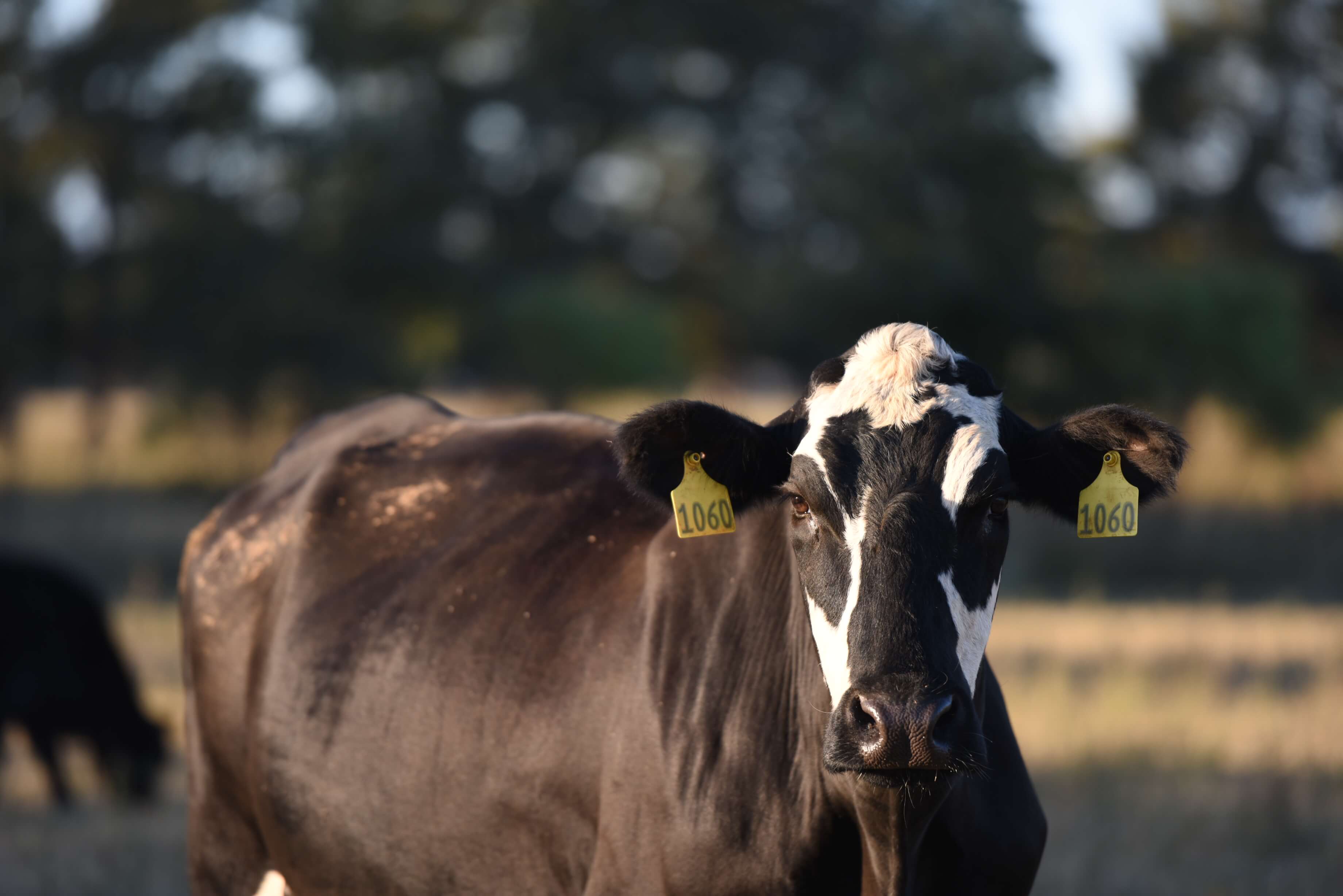
Waste
Conventional beef producers operate in a linear, extractive system. Cattle are brought to a processing plant and slaughtered for products that can be sold in a grocery store or wholesale. The rest of the animal is viewed as a waste product, with valuable nutrients sold to renderers.
Our farm is committed to zero waste practices, meaning that if we can't sell something to customers, we still view it as part of a natural cycle. We turn some of the animal into handmade leather products, tallow products, or pet chews. If we cannot use a part of the animal, like blood and certain viscera, we compost it and return the nutrients to the soil in our pasture.
Slaughter
Conventional cattle are slaughtered in systems that give a traumatic end-of-life for the animals. They are first packed into large trucks to be transported long distances to centralized meatpacking plants. Most plants rely on mechanized slaughter methods for maximum speed of slaughter. Some plants can slaughter 400 head of cattle per HOUR.
Our cattle are slaughtered and butchered by hand in our on-farm, zero-waste, USDA-inspected processing abattoir. The animals do not need to travel long distances to our on-farm processing plant. Our workers move the cattle by hand throughout the plant, running our abattoirs at what we call a humane rate of slaughter. These efforts prioritize the welfare of both our animals and our employees. Our red meat plant slaughters about 100 head of cattle per WEEK.
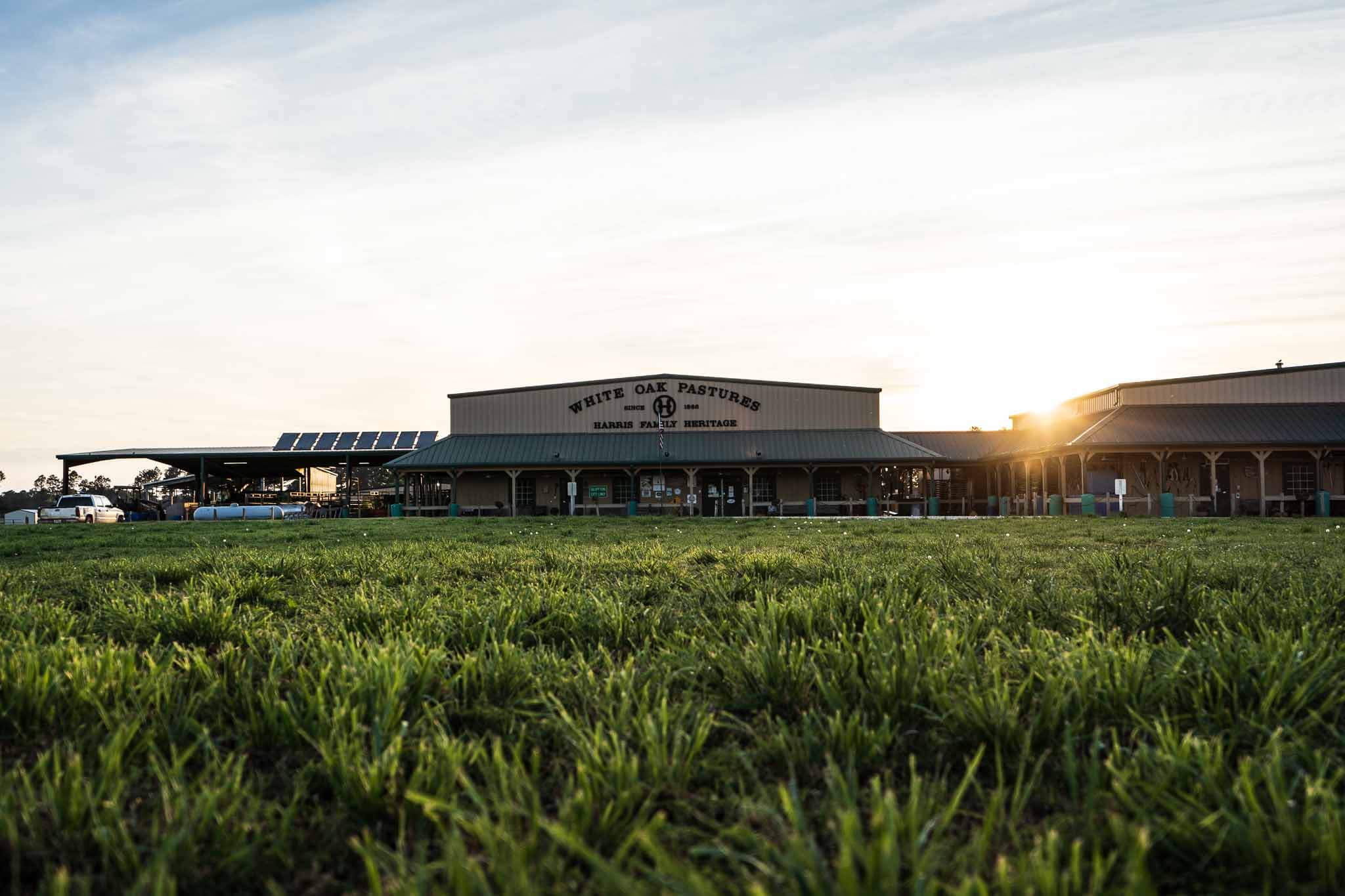
Worker Conditions
Conventional cattle are processed by meatpacking workers who receive low wages and operate in unsafe working conditions. These large, centralized meatpacking plants continue to destabilize our country’s food system and make it more fragile.
Our cattle are processed in our on-farm abattoir, providing local jobs that are kept in our community. With 165 employees, our farm is the largest private employer in one of the poorest counties, in one of the poorest states in the country. These opportunities power rural revival and help create a resilient food system.
Resiliency
On April 27, 2020, a headline on CNN read a quote from a Tyson executive: “Food Supply Is Breaking” in the U.S. The consolidation of these multinational companies over decades leaves them incredibly fragile to any disruptions. There are fewer meatpacking plants than ever: just 50 plants process 98% of America’s meat supply. So when a dozen of the big processing plants close, their entire production system starts to break down.
Our on-farm processing plant is designed to withstand shocks to the system, because we have built resiliency into our operations. Our pasture-raised animals are healthy enough that we can simply let them stay on pasture in the case of a delay in scheduled slaughter (and they don’t die of sedentary diseases in the meantime). Our two on-farm abattoirs are run at a humane rate of slaughter, valuing the life of both our livestock and our workers. Because of our size and business model, we are able to modify operations as needed to ensure the health and safety of our workers and community.

In the words of Will Harris,
“The food production industry traded its resiliency for efficiency. It was a really bad swap. Especially for the animals, the environment, and rural America. To gain this efficiency, in order to produce obscenely cheap food, the cycles of nature were made to be linear. This allowed food production to be scaled up… To the point where it is too big to succeed.”
At White Oak Pastures, we are proud to raise our cattle using methods that benefit animal welfare, rural revival, and land regeneration.
Want to see more about our grassfed beef? Check out this video with our cattle crew, with our Cattle Production Manager showing a day in the life of a White Oak Pastures cowboy.
